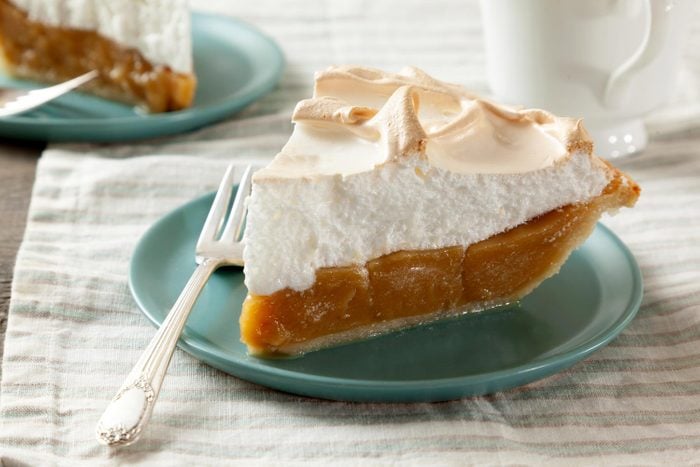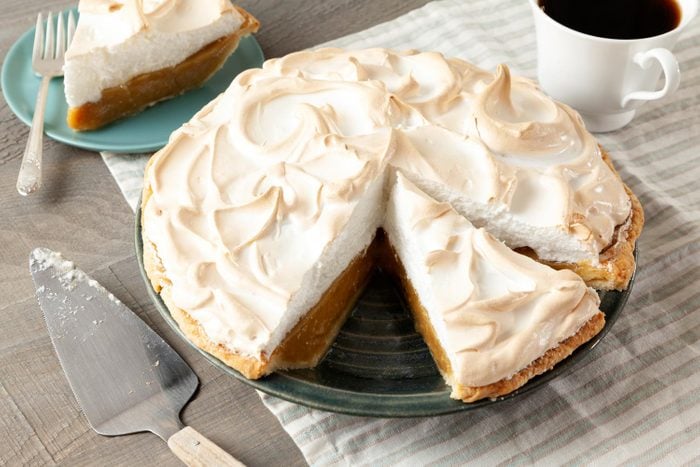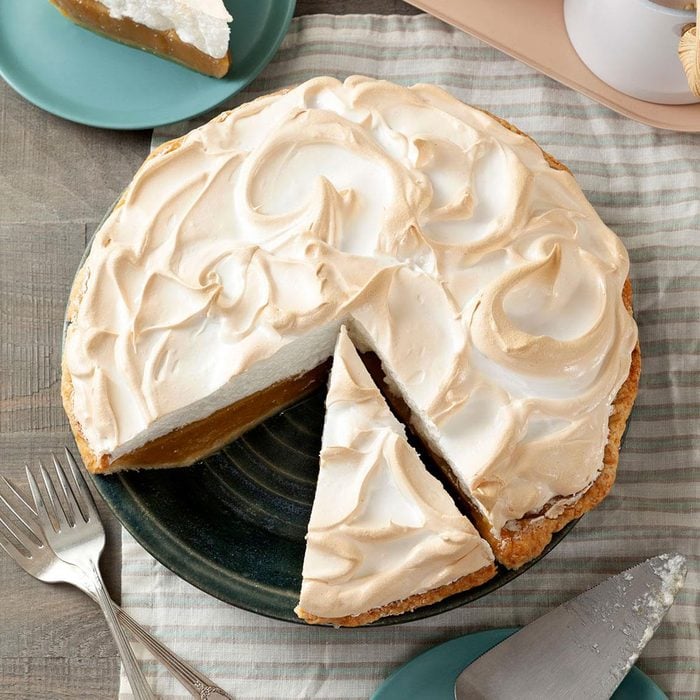This butterscotch pie is the perfect make-ahead dessert that’s guaranteed to finish your party on the right note. The pie features a buttery crust that’s filled with a liquid-gold butterscotch custard and topped with a toasted and fluffy meringue. Grandma and Grandpa probably told you how delicious those old-school butterscotch recipes are for their rich, complex flavor, and we’re here to tell you that they were absolutely right (as they usually are).
Don’t confuse butterscotch with caramel or toffee. The difference between caramel, butterscotch and toffee lies in the ingredients and cooking techniques. Toffee is cooked until it’s hard and brittle, unlike caramel and butterscotch’s more liquid-y state. Caramel and butterscotch are very similar, but caramel is made with white sugar while butterscotch is made with brown sugar. Brown sugar has a deeper, richer flavor than white sugar, which results in a more complex treat.
Ingredients for Butterscotch Pie

- Dough for single-crust pie: You can use a store-bought or homemade crust in our butterscotch pie recipe.
- All-purpose flour: All-purpose flour thickens the butterscotch filling so the pie is not a soupy mess when you cut into it.
- Brown sugar: Brown sugar is a primary ingredient in butterscotch, giving the caramel-y taste and beautiful golden hue in the pie’s butterscotch filling.
- Whole milk: Whole milk adds flavor and fat to the butterscotch filling. We do not recommend a milk with less fat, as it would make the filling more watery than creamy.
- Egg yolks: Egg yolks create a custard filling’s rich texture and flavor.
- Egg whites: Room-temperature egg whites fluff up nicely for a meringue. There should not be a speck of yolks in the egg whites, or else the egg whites won’t fluff up.
- Cream of tartar: Cream of tartar adds stability to the meringue and helps it whip up more successfully.
Directions
Step 1: Prepare the pie crust
On a lightly floured surface, roll the dough to a 1/8-inch-thick circle. Transfer the crust to a 9-inch pie plate. Trim the edges to a 1/2 inch beyond the rim of the plate, and flute the edges. Refrigerate the crust for 30 minutes. Preheat your oven to 425°F.
Editor’s Tip: If you want to get fancy with your fluting, learn how to make decorative pie crusts.
Step 2: Par-bake the crust
Line the unpricked crust with a double thickness of aluminum foil. Fill the foil with pie weights, dried beans or uncooked rice. Bake on a lower oven rack until the edges are light golden brown, 15 to 20 minutes. Remove the foil and the weights. Continue baking until the bottom of the crust is golden brown, three to six minutes longer. Cool the crust at room temperature on a wire rack. Reduce the oven setting to 350°.
Step 3: Make the hot butter mixture
In a saucepan, melt the butter. Remove the saucepan from heat. Add the flour, and whisk until smooth. Whisk in the brown sugar. Return the saucepan to the heat, and whisk in the milk and salt until blended. Cook and whisk over medium-high heat until the mixture is thickened and bubbly. Reduce the heat, and cook and whisk for two minutes longer.
Step 4: Temper the eggs
Remove the saucepan from heat. Slowly stream about 1 cup of the hot butter mixture into the egg yolks while whisking constantly. Return the egg mixture to the saucepan, whisking constantly. Bring to a gentle boil. Cook, whisking, for two minutes longer. Remove the saucepan from heat. Gently whisk in the vanilla. Pour the filling into the crust.
Editor’s Tip: Don’t end up with scrambled eggs in your filling! Learn how to temper eggs like a pro so your butterscotch custard filling turns out luscious and silky.
Step 5: Whip up the meringue
Using a hand mixer or stand mixer, beat the egg whites and cream of tartar on medium speed in a small bowl until soft peaks form. Gradually beat in the sugar, about 1 tablespoon at a time, on high speed until stiff, glossy peaks form and the sugar is dissolved. Spread the meringue evenly over the hot filling, sealing the meringue to the edge of the crust.
Editor’s Tip: Before starting this step, make sure all your equipment is cleaned and dried thoroughly. Any fat or food left behind on the equipment will inhibit your meringue from whipping up.
Step 6: Bake the pie
Bake the pie until the meringue is golden brown, 12 to 15 minutes. Cool the pie at room temperature on a wire rack for one hour. Refrigerate the pie for at least three hours before serving. Refrigerate the leftovers.
Editor’s Tip: When cutting the pie into servings, first dip your knife into hot water, then cut into your pie to prevent the meringue from sticking to the knife.
Butterscotch Pie Variations
- Go for a graham cracker crust: A homemade graham cracker crust creates a crunchy layer that perfectly offsets the indulgently rich butterscotch filling.
- Use a different meringue: If you’re not a fan of an eggy, bubbly meringue, we suggest swapping it out for a Swiss meringue instead. Swiss meringue is incredibly smooth, fluffy, stable and reminiscent of a marshmallow.
- Top with spiced cookies: Biscoff or Speculoos cookie crumbles make an excellent topping for a warm, fall spice flavor and added crunch.
How to Store Butterscotch Pie

To store leftover butterscotch pie, insert toothpicks into the meringue so the toothpicks are sticking out quite a bit. Gently drape storage wrap over the toothpicks in the meringue (make sure the wrap is not touching the meringue) and around the pie. Store the pie in the refrigerator for up to two days.
Do not leave your butterscotch pie sitting out at room temperature. The best way to store baked goods made with cream and meringue is in the refrigerator.
Butterscotch Pie Tips
How do I make a single-crust pie dough?
To make a single-crust pie dough, whisk together 1-1/4 cups all-purpose flour and 1/4 teaspoon salt in a large bowl. Cut in 1/2 cup cold butter until the mixture is crumbly. Gradually add 3 to 5 tablespoons ice water, tossing with a fork until the dough holds together when pressed. Shape the dough into a disk, and wrap in storage wrap. Refrigerate for one hour.
Where did butterscotch pie originate?
Butterscotch pie originated at a creamery in Connersville, Indiana. The pie was created by Sarah Wheeler in 1904 and was later published in a cookbook.




















